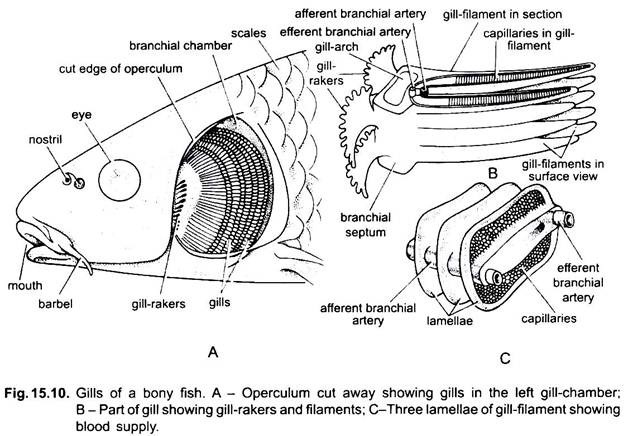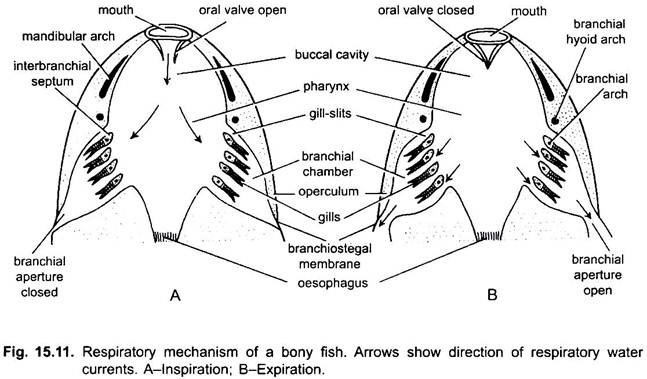In Labeo, respiration is aquatic, occurring with the help of gills.
Respiratory Organs:
In Labeo, there are four pairs of gills present in the branchial chambers covered by operculum. Each gill has a double row of gill-filaments or branchial-filaments supported by gill-arch. Each gill filament bears numerous minute transverse lamellae covered with thin epithelium. These lamellae contain capillaries of afferent and efferent branchial arteries. The four pairs of gills are borne on the first four branchial arches.
In Labeo and other teleosts the gill-filaments are attached to a very much reduced interbranchial septum. Thus, this type of gill is called pectinate or filiform. The fifth gill arch bears no gill-filaments. On the inner surface of operculum is a comb-like body, the pseudobranchia, formed of a single row of branchial- filaments, and representing either the vestigial gill (hemibranch) of the mandibular arch or the spiracular hemibranch.
Thus, there are 4 holobranchs attached to first four branchial arches and 5 gill-slits on either side covered by the operculum. The pharyngeal (inner) border of each gill- arch has spinous processes, called the gill-rakers which do not allow the food particles to enter into the branchial chamber.
Mechanism of Respiration:
ADVERTISEMENTS:
1. Inspiration:
During inspiration, outer opening of the gill-chamber remains tightly closed, i.e., opercula and the branchio-stegal membranes attached to the posterior margin of operculum, press upon the body to close the other opening. The branchial-arches and the opercula bulge laterally increasing the volume of bucco-pharyngeal cavity. Thus, the water flows in through the opened mouth to fill the enlarged bucco-pharyngeal cavity.
2. Expiration:
ADVERTISEMENTS:
During expiration, mouth becomes closed by oral valves, and the bucco-pharyngeal cavity contracts exerting pressure on the contained water. In the meantime the opercula and branchio-stegal membranes are lifted off, thus, the water from the bucco-pharyngeal cavity passes out through the gill-chamber, bathing the gill-filaments. Contraction and expansion of pharyngeal cavity occurs by alternate retraction and protraction of the hyoid arch which supports the bucco-pharyngeal cavity.
Physiology of Respiration:
The lamellae of gill-filaments are richly vascularised by the capillaries of afferent and efferent branchial arteries. Afferent branchials bring deoxygenated blood into the lamellae. Oxygen of water diffuses through the thin walls of blood capillaries into their blood and CO2 of the blood of these capillaries diffuses into the water. Thus, gaseous exchange occurs when blood passes out through the gill-chambers. The oxygenated blood is carried by the efferent branchial arteries and is supplied to the entire body.
Asphyxiation occurs when water is deficient in oxygen content or the fish is kept out of water for a long time. Due to asphyxiation the fish dies.

